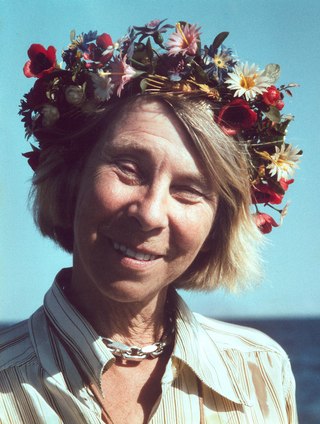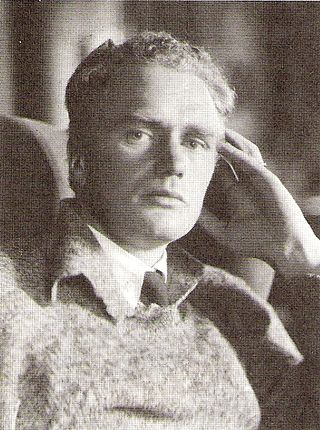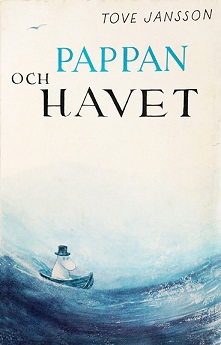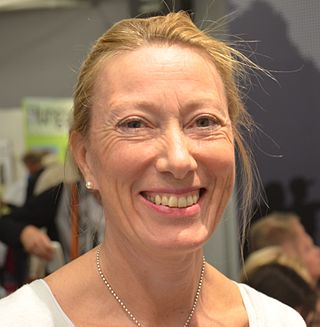Related Research Articles

Tove Marika Jansson was a Finnish author, novelist, painter, illustrator and comic strip author of Swedish descent. Brought up by artistic parents, Jansson studied art from 1930 to 1938 in Helsinki, Stockholm, and Paris. She held her first solo art exhibition in 1943. Over the same period, she penned short stories and articles for publication, and subsequently drew illustrations for book covers, advertisements, and postcards. She continued her work as an artist and writer for the rest of her life.

Snufkin is a character in the Moomin series of books written by Swedish-speaking Finn Tove Jansson, appearing in six of the nine books; his first appearance is in the second book, Comet in Moominland. He is the best friend of the series' protagonist, Moomintroll, and lives a nomadic lifestyle, only staying in Moominvalley in the spring and summer, but leaving for warmer climates down south every winter. He is the son of the elder Mymble and the Joxter, and is half-brother to the Mymble's daughter and Little My.

Moomin World is a theme park based on the Moomin books by Tove Jansson. It was designed by Dennis Livson, and is located on the island of Kailo next to the old town of Naantali, in Southwest Finland.

Comet in Moominland is the second in Finnish author Tove Jansson's series of Moomin books. Published in 1946, it marks the first appearance of several main characters, such as Snufkin and the Snork Maiden.

Jarl Robert Hemmer was a Swedish-speaking Finnish author. He was nominated for the Nobel Prize in Literature in six consecutive years.

Tales from Moominvalley is the seventh book in the Moomins series by Finnish author Tove Jansson. Unlike all the other books, which are novels, it is a collection of short stories, the longest book in the series. It was first published in 1962. The book forms the basis of episodes 9, 10, 13, 24, and 36 of the 1990 TV series.

Moominpappa at Sea is the eighth book in the Moomin books by Finnish author Tove Jansson. First published in 1965, the novel is set contemporaneously with Moominvalley in November (1970), and is the final installment in the series where the titular Moomin family are present within the narrative.

Moominvalley in November is the ninth and final book in the Moomin series by Finnish author Tove Jansson, and was first published in her native Swedish in 1970, and in English in 1971. Set contemporaneously with her previous novel Moominpappa at Sea (1965), it is the only installment in the series where the titular Moomin family are actually absent. Instead it focuses on a set of other characters, including Snufkin, who come to live at Moominhouse during the onset of winter whilst its inhabitants are away, and the various interactions which they have with each other.

The Dangerous Journey is a children's picture book in the Moomin series by Tove Jansson. It was published in 1977. It follows the nightmarish adventures of Susanna, the Hemulen, Sniff, Sorry-Oo and Thingummy & Bob through Moominvalley.

Moominvalley is a fictional place, where the Moomins live in the tales by Finnish author Tove Jansson.

Vivica Sophia Jansson is the daughter of cartoonist Lars Jansson and the niece of the famous Finnish writer and painter Tove Jansson. Jansson has worked as a Spanish language teacher, creative/artistic director, chairman, and majority shareholder of Oy Moomin Characters, Ltd, and provided direct oversight together with her father for the 1990 Moomin animated series.

The Moomins are the central characters in a series of novels, short stories, picture books, and a comic strip by Swedish-speaking Finnish writer and illustrator Tove Jansson, originally published in Swedish by Schildts in Finland. They are a family of white, round fairy-tale characters with large snouts that make them resemble the hippopotamus. However, despite this resemblance, the Moomin family are trolls. The family live in their house in Moominvalley.

Thomas Warburton was a Finnish writer, translator, and recipient of the Eino Leino Prize in 1997.

Tito Fritiof Colliander was a Finnish Eastern Orthodox Christian writer.

Moomin is a Dutch-Japanese anime television series produced by Telecable Benelux B.V. and animated by Telescreen Japan. Based on the Moomin novels and comic strips by the Finnish illustrator and author Tove Jansson and her brother Lars Jansson, it was the third anime adaptation of the property and the first to receive distribution in different countries worldwide. Moomin first aired on TV Tokyo from April 12, 1990, to October 3, 1991. The series had also been dubbed into English and aired on CBBC in United Kingdom during the same year.
Moominvalley is a British-Finnish animated family drama television series. An adaptation of the Moomin books and comics by writer-illustrator Tove Jansson and her brother Lars Jansson, it is created using new techniques in 3D CGI.

Sniff is a character in the Moomin stories created by Tove Jansson. His debut is in the first Moomin-book The Moomins and the Great Flood. In addition to books, he is also a prominent character in the Moomin comics and animations.

Kerberos was a Swedish language satirical magazine published in Helsinki, Finland, in the period 1917–1921. Its subtitle was Tidskrift för satir och humor.
Fyren was a satirical magazine focusing on politics which was published in Helsinki, Finland, between 1898 and 1922. It described itself as a social satire publication which supported free visual and written expressions.
References
- 1 2 3 4 5 6 Ant O’Neill (2017). "Moominvalley Fossils: Translating the Early Comics of Tove Jansson". Bookbird: A Journal of International Children's Literature. 55 (2): 52. doi:10.1353/bkb.2017.0023. ISSN 0006-7377. S2CID 151535137.
- 1 2 3 4 Anni Kangas (2007). The Knight, the Beast and the Treasure: a semeiotic inquiry into the Finnish political imaginary on Russia, 1918-1930s (PhD thesis). University of Tampere. pp. 62, 64. hdl:10024/67797. ISBN 978-951-44-7157-5.
- 1 2 3 4 5 "Tove Jansson's work at satire magazine Garm". Moomin. 10 March 2014. Archived from the original on 4 May 2021. Retrieved 12 September 2021.
- ↑ Kikka Rytkönen. "Black Moomins". Antimilitaristi (in Finnish). Retrieved 12 September 2021.
- ↑ Tapio Markkanen (Spring 2016). "Echoes of Cosmic Events and Global Politics in Moominvalley: Cosmic and Astronomical Sources of Incitement in Tove Jansson's Comet in Moominland". Acta Baltica Historiae et Philosophiae Scientiarum. 4 (1): 41–69. doi:10.11590/abhps.2016.1.02. hdl: 10138/233362 .
- ↑ Elina Druker (2012). "Mapping absence. Maps as meta-artistic discourse in literature". In Leif Dahlberg (ed.). Visualizing Law and Authority. Essays on Legal Aesthetics. Berlin; Boston: De Gruyter. p. 118. doi:10.1515/9783110285444.114. ISBN 978-3-1102-8537-6.
- 1 2 Hallie Wells (2019). "Between discretion and disclosure: Queer (e)labor(ations) in the work of Tove Jansson and Audre Lorde". Journal of Lesbian Studies . 23 (2): 233. doi:10.1080/10894160.2019.1520550. PMID 30632943. S2CID 58627968.